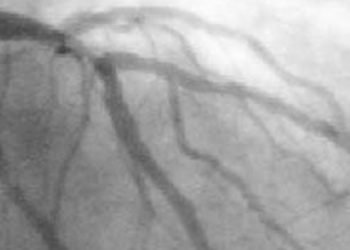The ROMICAT 1 trial: Coronary computed tomographic angiography highly sensitive for acute coronary syndrome in patients with acute chest pain [Classics Series]
The following study summary is an excerpt from the book 2 Minute Medicine’s The Classics in Radiology: Summaries of Clinically Relevant & Recent Landmark Studies, 1e (The Classics Series).
1. In patients presenting with chest pain and a low to intermediate risk of acute coronary syndrome (ACS), computed tomographic coronary angiography (CTCA) demonstrated high sensitivity and negative predictive value for acute coronary syndrome.
Original Date of Publication: May 2009
Study Rundown: Chest pain is one of the most common patient complaints and accounts for over 100 million emergency department visits every year in the U.S. alone. Most patients presenting with chest pain have not suffered an ACS, though many are admitted to hospital for further monitoring and testing. CTCA is a rapid test that can identify significant stenoses in the coronary arteries, though its utility in chest pain evaluation was unclear at the time of this study, having only been assessed in several small studies.
The Rule Out Myocardial Infarction using Computer Assisted Tomography 1 (ROMICAT 1) trial was a blinded prospective cohort study that sought to determine whether CTCA was useful in assessing patients with acute chest pain and low to intermediate risk of ACS. The absence of coronary artery disease on CTCA demonstrated a sensitivity of 100% and a negative predictive value (NPV) of 100% for ACS. Thus, CTCA may be of high utility in evaluating patients with chest pain in the emergency department and facilitate more rapid discharge of patients with low to intermediate likelihood of ACS. Additional radiation exposure remains one of the limitations inherent in this technology, though decreasingly so with modern techniques including prospective electrocardiogram (ECG) triggering.
In-Depth [prospective cohort]: This study examined 368 patients who were >18 years of age, presented to the emergency department with chest pain lasting >5 minutes in the previous 24 hours, had initially normal troponin levels and ECG, were suspected to have ischemic chest pain, were admitted to the hospital to rule out myocardial infarction (MI), and were able to perform a breath hold of 10-15 seconds. Exclusion criteria included initial elevation in troponin or CK-MB levels, new diagnostic ECG changes (ST-segment elevation or depression ≥1 mm or T wave inversions >4 mm in 2 contiguous leads), hemodynamic or clinical instability, known allergy to iodinated contrast, and history of established coronary artery disease (previous stent implantation or coronary bypass grafting).
CT imaging was performed using a 64-slice scanner (Sensation 64, Siemens Medical Solutions) with iodinated contrast. Patients with a heart rate >60 beats/min received intravenous metoprolol 5-20 mg, unless their systolic blood pressure was <100 mmHg. Axial images were reconstructed using a retrospectively ECG-gated algorithm. The presence of significant coronary artery stenosis was defined as any luminal obstruction >50% in any coronary segment.
By CTCA, 183 patients (50%) were found to have no coronary disease. In this cohort, identifying no plaque demonstrated a sensitivity and NPV of 100% (95%CI 89-100%) and 100% (95%CI 98-100%), respectively, for ACS. Finding any plaque yielded a specificity of 54% (95%CI 49-60%) for ACS with a positive predictive value (PPV) of 17%. The absence of significant coronary stenosis demonstrated a sensitivity of 77% (95%CI 59-90%) and a NPV of 98%, while the presence of coronary stenosis demonstrated a specificity of 87% (95%CI 83-90%) and a PPV of 35%. Additionally, both plaque and stenosis, as assessed on CTA, predicted ACS independent of cardiovascular risk factors or TIMI risk score (AUC 0.88, 0.82 versus 0.63, respectively; all p < 0.05).
Click to read the study in the Journal of the American College of Cardiology
Hoffmann U, Bamberg F, Chae CU, Nichols JH, Rogers IS, Seneviratne SK, et al. Coronary Computed Tomography Angiography for Early Triage of Patients With Acute Chest Pain. The ROMICAT (Rule Out Myocardial Infarction using Computer Assisted Tomography) Trial. J Am Coll Cardiol. 2009 May 5;53(18):1642–50.
©2018 2 Minute Medicine, Inc. All rights reserved. No works may be reproduced without expressed written consent from 2 Minute Medicine, Inc. Inquire about licensing here. No article should be construed as medical advice and is not intended as such by the authors or by 2 Minute Medicine, Inc.







